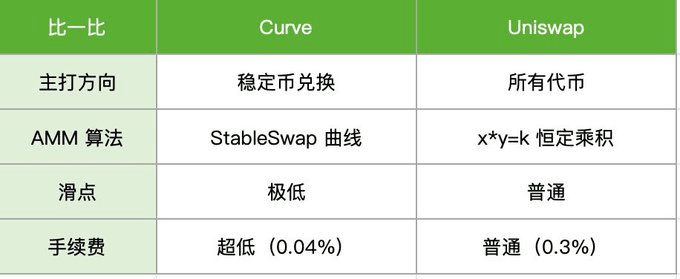Today, let’s talk about the 'stablecoin dam' of the DeFi world — Curve, an old OG that has perfected AMM.

🌀 What exactly is Curve?
Curve is a DEX designed specifically for stablecoin swaps, with a focus on four words: 'ultra-low slippage'.
Unlike ‘universal’ DEXs like Uniswap, Curve is a dedicated highway for stablecoins. Swapping between USDT, USDC, and DAI incurs almost no loss.
It is a variant of AMM, with an algorithm specifically optimized for swapping 'assets with very close prices'.
⚙️ How is it different from Uniswap?

Curve's algorithm is more like 'slow and steady', with high capital utilization, suitable for large swaps.
Uniswap's curve is more suited for trading pairs with larger price fluctuations.
🧩 Why is Curve important?
Before Curve appeared, swapping 1 million USDC ➡ USDT on Uniswap could easily result in a 0.5% slippage, costing you $5,000 for nothing.
Curve is here to solve this problem — its StableSwap algorithm is specifically optimized for scenarios where 'the prices are almost the same but require a large swap'.
From the very beginning, it stands at the ceiling of the stablecoin track.

🧬 The evolution of Curve
v1: stablecoin exclusive pool, maximized efficiency
v2: supports non-stable assets, creating dynamic curves
v3 (LlamaLend): cross-border lending
crvUSD: launching its own stablecoin, challenging MakerDAO
Curve doesn’t just want to be a DEX; it aims to be the liquidity foundation of the entire DeFi ecosystem.
💰 What does the CRV & veCRV model mean?
The token for Curve is $CRV, but the real power lies in the veCRV system.
Locking up CRV and turning it into veCRV allows you to: participate in governance.
Earn transaction fees
Decide how to distribute incentives (whoever's pool gets more CRV rewards)
This is the legendary beginning of the Curve War —
Major protocols began buying CRV, locking up veCRV, and engaging in incentive battles to get more rewards for their liquidity pools.
⚔️ How did the Curve Wars start?
Projects are rushing to accumulate veCRV to earn more CRV rewards; the more you accumulate, the more incentive votes you can cast for your pool.
Later, tools specifically for 'assistance in battle' appeared:
Convex Finance: integrates your CRV, helping you with locking, voting, and maximizing yields.
Frax, Redacted: professionals in the Curve War, greatly influencing Curve’s voting outcomes.
Only Curve could turn a DEX into a political ecosystem.
⚠️ Do you remember that crisis?
In 2023, Curve's founder Michael had multiple lending positions exposed on-chain, borrowing a lot of money using CRV as collateral. The market panicked, CRV's price plummeted, almost triggering a chain liquidation.
This event also woke everyone up:
Founder risk is not exclusive to centralized projects; DeFi must also keep an eye on the on-chain actions of key individuals.
🧱 How important is Curve?
Now, let’s summarize one last time 👇
✅ The top facility for stablecoin swaps
USDT-USDC-DAI swaps generally happen on Curve, with low slippage and high efficiency.
✅ Founder of veTokenomics
You can vote, earn rewards, and control incentives only by locking up tokens — this model has been copied by many projects (Balancer, Frax, Trader Joe).
✅ A true model of 'real yield'
Not relying on inflation to distribute tokens, but instead using transaction fees to support long-term players.
✅ The political battlefield of DeFi
The Curve War is a real example of economic incentives + governance games, one of the hallmarks of DeFi maturation.
🗣️ Written at the end
Curve is like the 'stablecoin dam' of the DeFi world, efficiently exchanging stablecoins.
Now they have also launched crvUSD to take on MakerDAO directly, and there are many more stories to come.
📌 We’ll continue discussing the next protocol tomorrow! Which one do you want to hear? Call it out in the comments!
📣 Do you like this DeFi series explanation? Like + share to support me in continuing this 🙌